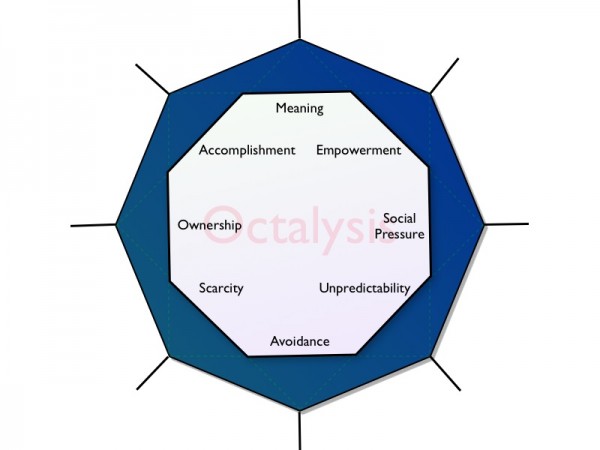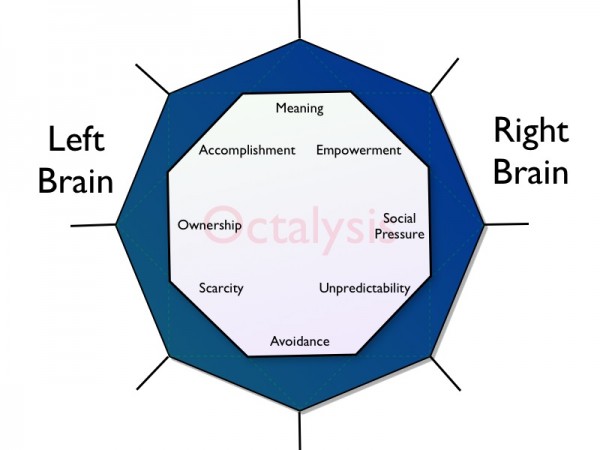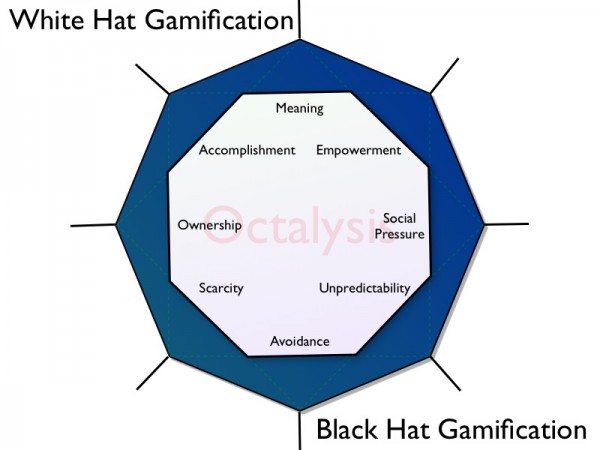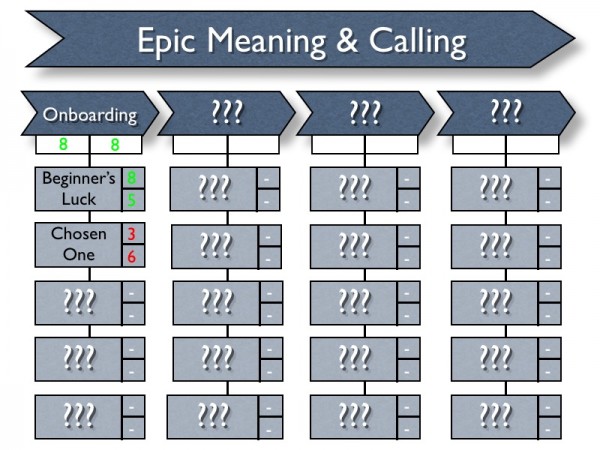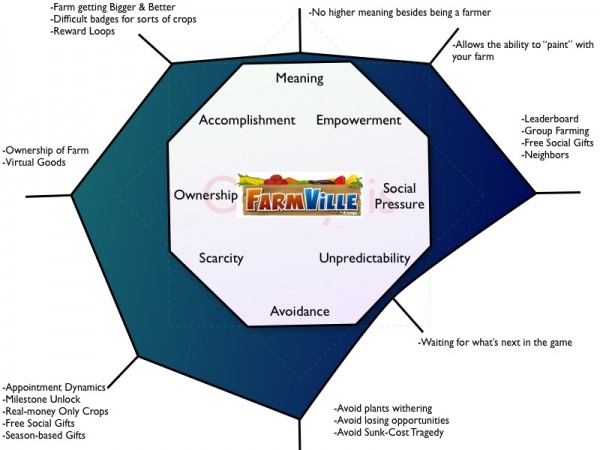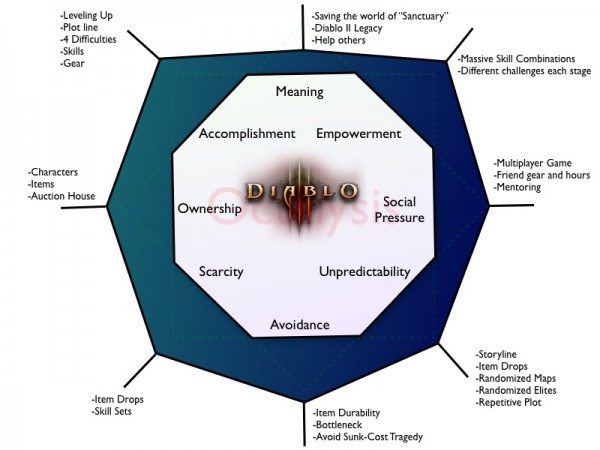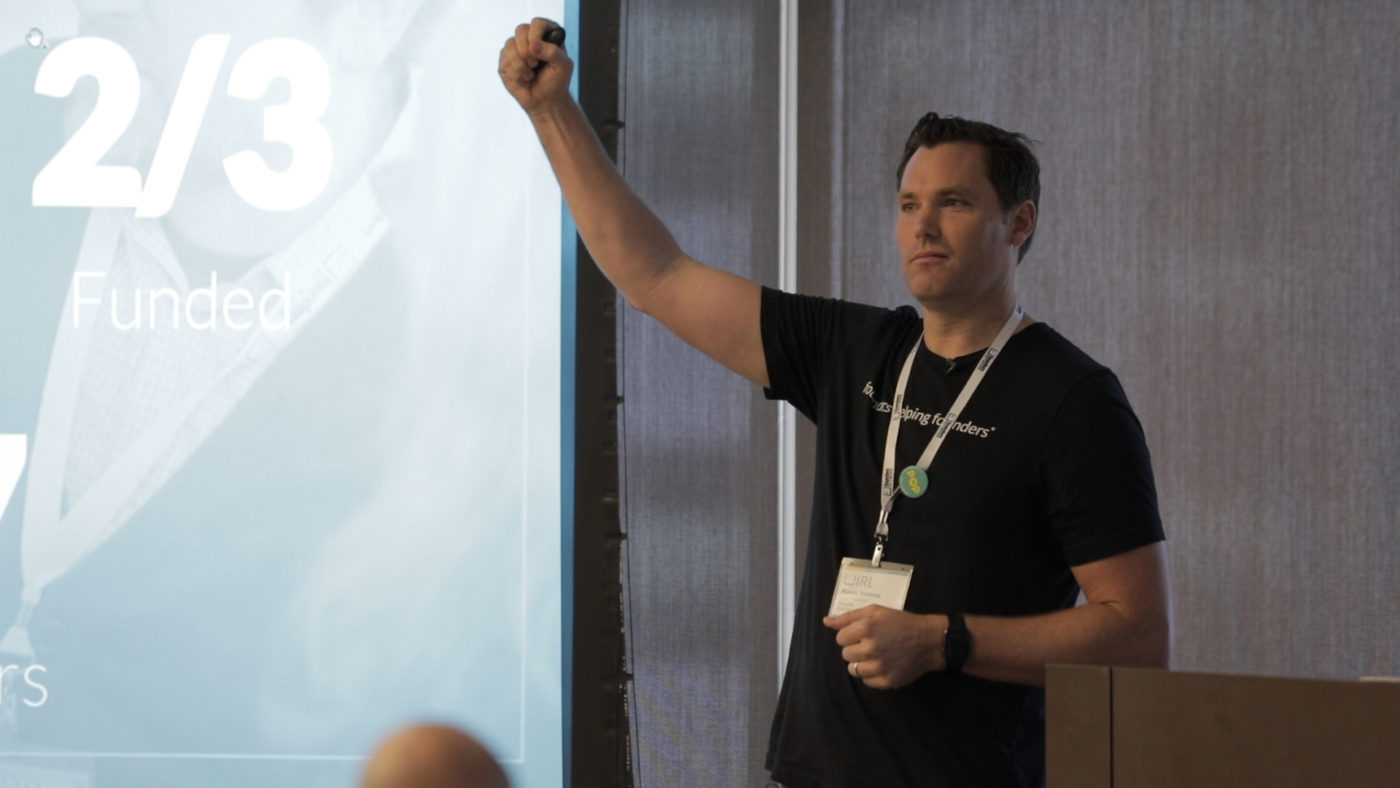
The following is a guest post from fnBlog Contributor Yu-kai Chou, Co-Founder of RewardMe. Yu-kai most recently contributed to buy viagra in canadasnetwork.com/2012/10/gamification-research-how-farmville-uses-game-mechanics-to-become-winning-addicting/”>Gamification Research: How FarmVille uses Game Mechanics to become Winning & Addicting. This post, originally posted on Yu-kai’s Gamification Framework Blog, discusses the concept of Octalysis and how you can apply this gamification concept to your startup business.
Octalysis: Complete Gamification Framework
Gamification is simply design that remembers the “human” in the process. In essence, it is Human-Focused Design (as opposed to “function-focused design”).
Most processes design around function and efficiency – it tries to get the job done as quickly as possible. Games, however, has a sole focus of pleasing the “human” in the process.
This is why even though many Gamification techniques were around way before the term or even “games” were around, games were one of the earliest to holistically understand Human-Based Design, so now we call it Gamification.
In the past few months, I have been digging deep into formulating a complete framework to analyze and strategize various systems of Gamification.
I first started with digging deep into actual games that are Addicting such as FarmVille and Diablo 3, and then I derived out all the fun and addicting elements within those games.
At the end, I finally came up with a system that I feel is instructive, actually useful, and elegant. I call it Octalysis, and it starts with the 8 Core Drives.
The 8 Core Drives
Epic Meaning and Calling
This is the Core Drive where player believes that he is doing something greater than himself or he was “chosen” to play. This is when players devote a lot of their time to maintain a forum or help create things for the entire community (think Wikipedia or Open Source projects). This also comes into effect when someone has “Beginner’s Luck”, where people believe they have some type of gift that others don’t, or they were SUPER lucky to get that amazing sword at the beginning.
Development and Accomplishment
This is the internal drive of making progress, getting better at things, and finally overcoming challenges. The word “challenge” here is very important as “badges” without a challenge is not meaningful at all. People have asked me what Core Drive does Google use to become so successful, and I would say this one: Google makes you feel smart and accomplished with seconds. (On the other hand, Yahoo does not, but appeals to the Curiosity and Unpredictability core drive)
Expression of Creativity and Feedback
This is when users are addicted to a creative process where they have to continuously figure things out and try different combos. People not only need ways to express their creativity, but they need to be able to see the results of their creativity and more tries to adjust that. This is why Lego and paint is continuously fun and could often become Evergreen Mechanic (a good state for Gamification)
Ownership and Possession
This is the drive to “want” something. When a player feels ownership towards something, she automatically wants to make what she owns better and own more. If you feel ownership over your job, you will work harder. If you want ownership over the digital sheep, you will harass your friends. This is a strong drive behind all virtual goods and “collection” games.
Social Pressure and Envy
This drive incorporates all the social elements that drive people to do stuff. Anywhere from mentorship, acceptance, social responses, companionship, all the way to competition and envy. When you see a friend that is amazing at some skills or has amazing gear, you become driven to reach the same level. Gotta catch up with them Jone’s.
Scarcity and Impatience
This is specifically the drive of “wanting something because you can’t get it”. Many games have Appointment Dynamics within (come back 2 hours later to get your stuff), and just the fact that people can’t get it, motivates them to think about it all day long. In the early days of Twitter, it kept going down because of bad infrastructure (that’s how the Fail Whale became so famous). However, BECAUSE people couldn’t use Twitter when they wanted to, they wanted to use it even more, and they rushed to tweet when it wasn’t down. That was also the secret of Cartmanland.
Curiosity and Unpredictability
Generally, this is a harmless drive of wanting to find out what actually happens. Many people watch movies or read novels solely on this drive. However, this drive is something Gambling uses excessively, as researchers have found out that, people irrationally want to see what’s next when they know they will most likely lose but have some type of chance.
Loss and Avoidance
This final drive is based on the avoidance of something negative that could happen. On a light scale, it could be to avoid losing what you did earlier. On a larger scale, it could be to avoiding the Sunk-Cost Tragedy of admitting that everything you did up to this point was useless because you are now quitting.
After the 8 Core Drives are determined, I graphed them into an octagon chart.
Left Brain vs Right Brain Drives
In this Octagon, The Core Drives on the right are considered right brain drives, where it is more about creativity, self-expression, and social aspects.
The Core Drives on the left are considered left brain drives, where it is more about logic, calculations, and ownership.
White Hat vs Black Hat Gamification
At the same time, the top Core Drives in this Octagon are considered very positive motivations, while the bottom Core Drives are considered more negative motivations.
Therefore, I call techniques that heavily use the top ones “White Hat Gamification” while the bottom ones “Black Hat Gamification.”
If something is addicting because it lets you express your creativity, makes you feel achievement through mastery, as well as gives you a higher sense of meaning, that’s a very positive sense of being addicted.
On the other hand, If something is addictive because you don’t know what will happen next and you have to find out, you are constantly in fear of losing something, and simply because there are things you can’t have, then it is definitely from the Dark Side of the force of Gamification.
Keep in mind that just because something is Black Hat doesn’t mean its bad – these are just motivators that can be used for productive and healthy results, or for evil and control.
A good Gamification expert would try to implement all 8 Core Drives on a very positive and productive purpose, and everyone may turn out to be happier and healthier.
A deeper level of Octalysis
Beyond the above, I formulated a deeper layer for each branch to be analyzed, but for now I’ll keep that part as internal practice instead of public knowledge so I have a small competitive advantage ![]()
Below is an example of how the deeper layer would look (this is an example of a second-level analysis with the Epic Meaning and Calling Drive). Notice there are many cells to “unlock” and numbers to understand.
Since the entire framework is an analysis based on an Octagon shape, I call it Octalysis for Gamification.
How to apply Octalysis to actual systems
Now that we have the framework laid out, the next step is to figure out how to utilize this framework.
Generally, any GOOD and engaging product or system will have at least one of the core drives listed above.
The way to use Octalysis is to identify all the game mechanics that is used to appeal to each Core Drive and list it next to the Core Drive of the Octagon.
Afterwards, based on how strong these game mechanics are, each side of the Octagon will expand or retract.
If the side actually crosses the inside Octagon, then that means this side is extremely weak and the Gamification expert needs to improve on that.
Of course, that’s very abstract, so lets look at a few examples.
A few Gamiication examples with Octalysis
Here’s an Octalysis done for a few products online:
Diablo 3: pretty balanced but lacks Epic Meaning nor anything that excels
Twitter: pretty balanced but more Right Brain.
Feedback and Bashing Welcomed
I am still at the early phases of developing the Octalysis framework, so I’m sure I’ll go through plenty of revisions and improvements. In the meantime, feel free to bash it, slash it, and trash it. Also, if you would like to learn more about how to use Octalysis to improve your life or business, contact me and I’ll be happy help bring games (and Human-Focused Design) into your life.
Connect with Yu-Kai on Twitter @yukaichou or follow his blog. Want to learn more about RewardMe? Follow their blog.

